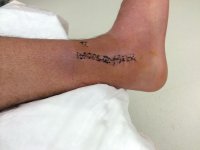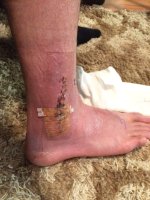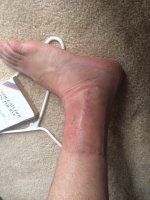- Feb 22, 2014
- 9
- 0
- 0
Greetings to all,
This post is to document my experience and provide information (good or bad) regarding my experience using AAS with the intent to aid a healing bone fracture.
Quick background:
I recently sustained a fracture of my distal right fibula. I am motivated to speed up my recovery as much as possible in order to achieve some important goals at work. I would like to avoid disclosing my line of work (anonymity purposes) but I need to be highly functional (strength, endurance, mobility) in several months. I could not find much information on the web regarding AAS use to help fractured bones heal. Most advice (which is very reasonable) is to lay off any AAS and let the bone heal naturally. However, due to my timetable & and a couple interesting publications, I decided to make myself a guinea pig.
References:
Influence of Anabolic Steroid on Tibial Fracture Healing in Rabbits)
Oxandrolone, an anabolic steroid,... [Wound Repair Regen. 2000 Mar-Apr] - PubMed - NCBI
For those interested, I will discuss my injury, my medical/treatment regimen and the healing process. I have a background in the medical field and will try to be as systematic as possible (without including to much extraneous information). I am keeping detailed records of the injury for myself. Please let me know if I am including too much information or if you would like to know something else.
Patient History:
33 y/o male with no significant prior medical history. Subject is 72” tall and weighs approximately 215lbs (15% BF).
AAS History:
The patient’s only experience with AAS was a test. enanthate (500mg qweekly) cycle in late 2012 and a test. enanthate (500mg qweekly) + anavar (50mg QD) cycle in mid 2013. Patient was very responsive to each cycle and able to make significant muscle gains while reducing body fat (was about 195lbs @ 18% BF prior to beginning AAS). The patient used adequate PCT and has maintained exercising allowing him to keep many of his gains.
History of present injury:
On day 0 the patient was subjected to a high velocity fall and sustained a fractured right fibula. There was no obvious dislocation of the joint and the patient was able to bear weight immediately. In the ER, X-rays revealed a spiral fracture of the distal right fibula with minimal displacement. Under stress, the ankle joint showed an unacceptable amount of instability and surgery was recommended.
On day 2 the patient underwent an open reduction and internal fixation of the fractured fibula with a plate and screws (approximately 6 screws). The surgery was uneventful and post-operative x-rays show that anatomical realignment was achieved (no syndesmotic screw was needed). The patient was placed in a hard cast and sent home with follow up in 2 weeks. Standard anticoagulation (low molecular weight heparin) was maintained while in the hospital and patient was discharged on 14 days of full dose aspirin.
On day 5, the patient was started on a novel diet/medical regimen with hopes to increase the standard recovery time for a broken fibula/ankle (3-6 months).
AAS regimen:
-250mg test enanthate weekly
-250mg of nandrolone weekly
Vitamins:
-Vitamin A 12500iu daily
-Vitamin B6 100mg daily
-Vitamin C 2000mg daily
-Vitamin D (cholecalciferol) 3000IU daily
-Magnesium 400mg daily
-Zinc 45mg daily
Diet:
12-15 kCal/lb per day
approximately:
-250gm of carbs
-250gm of protein
-70gm fat
Training:
Upper body 3x week (Mon – chest & abs, Wed – back & tris, Fri – bis & shoulders)
Physical therapy to dictate lower body activity
Week 1 (Post injury day 5-11):
-Patient is non-weight bearing and was confined mostly to couch. Pain control was primary issue and was well controlled with oral medications. The patient was able to discontinue all oral pain medications on day 11. Patient was able to move minimally around his house (to bathroom and kitchen) with full support from crutches. He experienced significant ankle pain upon transitioning from supine to upright. The pain lasted several minutes after standing. Wound was unable to be assessed due to hard cast. The patient was able to initiate his AAS/medication and diet on day 5 and remain compliant throughout the week.
Week 2 (Post injury day 12-18)
-Patient’s pain is significantly improved. Hard cast was removed on day 14 staples removed from wound. Wound appeared to be healing normally (see attached picture). Ankle demonstrated reduced flexibility but no significant contraction of the Achilles tendon. Significant wasting of the gastrocnemius was noted. Patient was placed in a removable boot (CAM boot). Patient experiencing minimal pain in ankle joint (during range of movement) or at surgical site. No follow up x-rays obtained.
Week 3 (Post injury date 19-25)
-On day 19 patient added 40mg of Oxandrolone daily to his regimen to aid in wound healing (see above reference). Pain is minimal and only noted after prolonged standing. Patient is still non weight bearing. Wound is continuing to heal and does not appear infected (see second attached picture). Patient started physical therapy on day 19. He was prescribed basic range of motion exercises with minimal resistance from elastic band.
Week 4 (Post injury date 26-32)
- Patient began weight bearing on day 29 (with use of CAM boot). Movement seems to be moderately limited to reduction in range of motion and not pain. Physical therapy progressed and patient has progressed to doing body weight squats (1/2 squats) and balancing on flat ground with injured foot. Patient continues AAS/medical and diet regimen. Patient was able to ride recumbent bike for 30 minutes without pain
Week 5 (Post injury date 33-39)
- Follow up x-rays (33 days after surgical reduction) show almost complete healing of the distal right fibular fracture. Wound has significantly healed and there is no evidence of infection (see 3rd attached picture). Patient is now cleared to transition out of CAM boot and into lace-up ankle brace (with normal footwear). Physical therapy should be adjusted according to patient’s improvement in status
This is the current place of my progress. The real test of progress will be when I am able to run. The orthopedic surgeon stated that the soonest he has seen someone run after this type of injury is 5 months post surgery. I will continue to document my progress. If people are interested I can keep this forum update as well.
Al the best
Dr. D
This post is to document my experience and provide information (good or bad) regarding my experience using AAS with the intent to aid a healing bone fracture.
Quick background:
I recently sustained a fracture of my distal right fibula. I am motivated to speed up my recovery as much as possible in order to achieve some important goals at work. I would like to avoid disclosing my line of work (anonymity purposes) but I need to be highly functional (strength, endurance, mobility) in several months. I could not find much information on the web regarding AAS use to help fractured bones heal. Most advice (which is very reasonable) is to lay off any AAS and let the bone heal naturally. However, due to my timetable & and a couple interesting publications, I decided to make myself a guinea pig.
References:
Influence of Anabolic Steroid on Tibial Fracture Healing in Rabbits)
Oxandrolone, an anabolic steroid,... [Wound Repair Regen. 2000 Mar-Apr] - PubMed - NCBI
For those interested, I will discuss my injury, my medical/treatment regimen and the healing process. I have a background in the medical field and will try to be as systematic as possible (without including to much extraneous information). I am keeping detailed records of the injury for myself. Please let me know if I am including too much information or if you would like to know something else.
Patient History:
33 y/o male with no significant prior medical history. Subject is 72” tall and weighs approximately 215lbs (15% BF).
AAS History:
The patient’s only experience with AAS was a test. enanthate (500mg qweekly) cycle in late 2012 and a test. enanthate (500mg qweekly) + anavar (50mg QD) cycle in mid 2013. Patient was very responsive to each cycle and able to make significant muscle gains while reducing body fat (was about 195lbs @ 18% BF prior to beginning AAS). The patient used adequate PCT and has maintained exercising allowing him to keep many of his gains.
History of present injury:
On day 0 the patient was subjected to a high velocity fall and sustained a fractured right fibula. There was no obvious dislocation of the joint and the patient was able to bear weight immediately. In the ER, X-rays revealed a spiral fracture of the distal right fibula with minimal displacement. Under stress, the ankle joint showed an unacceptable amount of instability and surgery was recommended.
On day 2 the patient underwent an open reduction and internal fixation of the fractured fibula with a plate and screws (approximately 6 screws). The surgery was uneventful and post-operative x-rays show that anatomical realignment was achieved (no syndesmotic screw was needed). The patient was placed in a hard cast and sent home with follow up in 2 weeks. Standard anticoagulation (low molecular weight heparin) was maintained while in the hospital and patient was discharged on 14 days of full dose aspirin.
On day 5, the patient was started on a novel diet/medical regimen with hopes to increase the standard recovery time for a broken fibula/ankle (3-6 months).
AAS regimen:
-250mg test enanthate weekly
-250mg of nandrolone weekly
Vitamins:
-Vitamin A 12500iu daily
-Vitamin B6 100mg daily
-Vitamin C 2000mg daily
-Vitamin D (cholecalciferol) 3000IU daily
-Magnesium 400mg daily
-Zinc 45mg daily
Diet:
12-15 kCal/lb per day
approximately:
-250gm of carbs
-250gm of protein
-70gm fat
Training:
Upper body 3x week (Mon – chest & abs, Wed – back & tris, Fri – bis & shoulders)
Physical therapy to dictate lower body activity
Week 1 (Post injury day 5-11):
-Patient is non-weight bearing and was confined mostly to couch. Pain control was primary issue and was well controlled with oral medications. The patient was able to discontinue all oral pain medications on day 11. Patient was able to move minimally around his house (to bathroom and kitchen) with full support from crutches. He experienced significant ankle pain upon transitioning from supine to upright. The pain lasted several minutes after standing. Wound was unable to be assessed due to hard cast. The patient was able to initiate his AAS/medication and diet on day 5 and remain compliant throughout the week.
Week 2 (Post injury day 12-18)
-Patient’s pain is significantly improved. Hard cast was removed on day 14 staples removed from wound. Wound appeared to be healing normally (see attached picture). Ankle demonstrated reduced flexibility but no significant contraction of the Achilles tendon. Significant wasting of the gastrocnemius was noted. Patient was placed in a removable boot (CAM boot). Patient experiencing minimal pain in ankle joint (during range of movement) or at surgical site. No follow up x-rays obtained.
Week 3 (Post injury date 19-25)
-On day 19 patient added 40mg of Oxandrolone daily to his regimen to aid in wound healing (see above reference). Pain is minimal and only noted after prolonged standing. Patient is still non weight bearing. Wound is continuing to heal and does not appear infected (see second attached picture). Patient started physical therapy on day 19. He was prescribed basic range of motion exercises with minimal resistance from elastic band.
Week 4 (Post injury date 26-32)
- Patient began weight bearing on day 29 (with use of CAM boot). Movement seems to be moderately limited to reduction in range of motion and not pain. Physical therapy progressed and patient has progressed to doing body weight squats (1/2 squats) and balancing on flat ground with injured foot. Patient continues AAS/medical and diet regimen. Patient was able to ride recumbent bike for 30 minutes without pain
Week 5 (Post injury date 33-39)
- Follow up x-rays (33 days after surgical reduction) show almost complete healing of the distal right fibular fracture. Wound has significantly healed and there is no evidence of infection (see 3rd attached picture). Patient is now cleared to transition out of CAM boot and into lace-up ankle brace (with normal footwear). Physical therapy should be adjusted according to patient’s improvement in status
This is the current place of my progress. The real test of progress will be when I am able to run. The orthopedic surgeon stated that the soonest he has seen someone run after this type of injury is 5 months post surgery. I will continue to document my progress. If people are interested I can keep this forum update as well.
Al the best
Dr. D





























